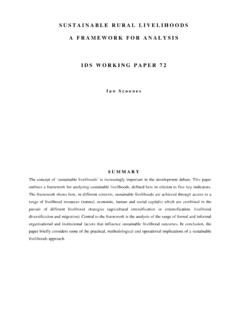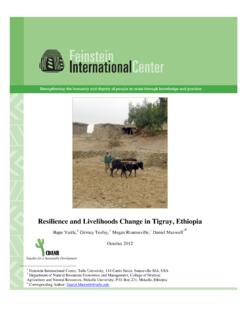Transcription of ANNEX 1: LOGICAL FRAMEWORK
1 61 ANNEX 1: LOGICAL FRAMEWORK61 Expected resultsIndicatorsMeans of verificationAssumptionsGoal: Improved food security and livelihoods of rural populations in North SudanOutcome 1 Improved preparedness for, and effective response to, food and agricultural threats and emergencies in North Cluster approach applied and implementing agriculture and food security cluster plans that comply with FAO s technical criteria for such Needs assessments lead to coordinated national response plans and Emergency programmes implemented using socio-economic and gender analysis tools that comply with FAO At least 10% increase in the level of funding provided to agricultural transition. Yearly country reports. FSL Cluster conducive environment for households to engage in production (stable security, reliable rainfall, etc.).Funds are secured in time and in sufficient amount for the implementation of financial and food crisis situations crop production and Community organization and institutions New business approaches for income generation and value addition Households provided with agricultural inputs and extension services increase area cultivated and average yield.
2 M&E and progress reports. Assessment reports (CFSAM, pre- and post-harvest assessment reports). Training livestock health and Improved both access to veterinary services and service Decreased incidence of livestock disease Improved access to livestock feeds and livestock watering Reduced conflict over pastures and water for livestock. M&E and progress reports. Assessment reports. Training environmental restoration and Increased access to quality and environmentally friendly alternative income sources to support livelihoods for IDP, returnee and conflict-affected sedentary Participatory community-based dialogue platforms at locality and community levels established, strengthened and made functional to address emerging resource-related Participatory action plans to address resource limitations in the flash point areas developed. Survey and study reports.
3 Progress reports. Training livelihoods diversification and technology Increased awareness of available livelihood options within the agriculture Improved adoption of production technologies and At least 10% increase in the level of funding provided to agricultural transition. M&E and progress reports. Assessment reports. conducive environment for households to engage in production (stable security, reliable rainfall, etc.).Funds are secured in time and in sufficient amount for the implementation of financial and food crisis situations Improved institutional and technical capacities of the Government and communities in early warning, preparedness, mitigation and Improved institutional and technical capacities of the Government and communities in early warning, preparedness, mitigation and Capacity built in basic public administration, policy and strategic planning of public institutions with agriculture and rural development in selected states and Government of National Unity capacity in management and decision-making for food security International community capacity in identifying livelihood profiles and the necessary responses outlined.
4 Views and opinions of Government counterparts. Food Security Technical Secretariat reports. Progress and final reports. Assessment reports. Meeting coordination of FSL Cluster Improved coordination of food security and livelihoods interventions leading to reduced gaps and duplication of activities in target areas, and efficient use of the limited Improved coverage and impact of food security and livelihoods interventions in target RAF and protocols adapted and tested in IPC Response Analysis Protocol adapted and tested in Lessons learned shared with partners in the Sudan and the East Africa region. Views and opinions of FSL actors and stakeholders about coordination. Assessment reports. Meeting 2: PROGRAMME PROFILES Output 1: Improved crop production and productivityProgramme and supporting the community-based seed production and supply increase the availability of and access to, and improve the quality of locally produced seeds and planting National Research Corporation, MARF, 6 NGOs, and 10 farmers groups in National Research Corporation, MARF, 4 NGOs, and 5-10 farmers groups in the rest of the ultimate beneficiaries of the produced seeds will be vulnerable households (IDPs, returnees, and host communities), including farmers, agropastoralists and partnersNational Research Corporation, MARF, international and national NGOs, CBOs, and farmers requested for DarfurUSD 1 716 requested for the rest of the Sudan USD 1 144 funds requestedUSD 2 860 overall priority in North Sudan is to increase the availability of and access to, and improve the quality of, locally produced seeds and planting materials.
5 In the Greater Darfur region, in particular, lessons learned in Southern Sudan will be applied in the implementation of a CBDRR programme for seed production and supply. FAO also plans to carry out an SSSA in order to review the functioning of the formal and informal seed systems that are used by farmers. The SSSA assesses whether seed of adequate quality is available and accessible to farmers. The approach promotes strategic thinking about the required relief, recovery or development vision. An SSSA goes well beyond a conventional seed needs assessment as it reveals the specific security problems faced by communities and then steers responses towards actions that alleviate specific constraints and often improve systems. The overall objective of this SSSA would be to improve the food security and livelihoods of vulnerable farming families by identifying strategies to address acute and chronic seed insecurity.
6 This will be crucial for redirecting activities planned for 2011. In the Transitional Areas, FAO has been working through CHF- and UNDP-financed projects that combine a series of elements covering crop and livestock production, environmental protection and restoration, income generation and capacity building of partners and beneficiaries. The lessons learned during the implementation of the DDR project in Eastern Sudan (Kassala state) are being applied in the implementation of DDR projects in Blue Nile and Southern Kordofan. In these, community participation in seed collection and distribution was vital to improve seed distribution mechanisms. This experience will also continue through the JFFLS in Southern Kordofan in collaboration with has been working in Eastern Sudan since 2004 and has implemented a range of projects covering crop/livestock protection and production, environmental issues, and income generation, among others.
7 There is need for additional support in many of the same areas, mainly targeting the most vulnerable (returnees, refugees, ex-combatants) and emphasizing sustainability, and outcomes: Restored seed production and supply outputs: Strengthened community-based seed production and supply system. Increased seed production and availability. Improved access to quality locally produced seeds and planting materials. Improved knowledge and skills in crop production. Key activities: Support the restoration of the indigenous seed system. Community-based seed production and supply. Provide agricultural inputs (direct distribution of seeds and tools, voucher and fair schemes, etc.). Establish community seed banks. Set up JFFLS and share the experience with partners. Use socio-economic and gender analysis tools to identify the most vulnerable to Darfur, on CBDRR: Conduct a comprehensive addition and to start working on CBDRR: Conduct participatory disaster risk appraisal and provide capacity development training on CBDRR.
8 Undertake integrated CBDRR interventions by providing livelihoods support through resource transfers. Promote awareness and advocacy on CBDRR and build resilience of vulnerable communities to hazards and for Darfur Budget Year 1 Year 2 Amount (USD)Personnel 45 00045 00090 000 Contracts150 000150 000300 000Tr ave l30 00030 00060 000 Training45 00045 00090 000 Expendable equipment 450 000450 000900 000 Non-expendable equipment 15 00015 00030 000 Technical support services 15 00015 00030 000 General operating expenses 30 00030 00060 000 Sub-total780 000780 0001 560 000 Support costs 78 00078 000156 000 Total858 000858 0001 716 0006565 Budget for the rest of the Sudan Budget Year 1 Year 2 Amount (USD)Personnel 30 00030 00060 000 Contracts100 000100 000200 000 Travel 20 00020 00040 000 Training 30 00030 00060 000 Expendable equipment 300 000300 000600 000 Non-expendable equipment 10 00010 00020 000 Technical support services 10 00010 00020 000 General operating expenses 20 00020 00040 000 Sub-total520 000520 0001 040 000 Support costs52 00052 000104 000 Total572 000572 0001 144 000 Total budget 1 430 0001 430 0002 860 00066 Output 1.
9 Improved crop production and productivityProgramme agricultural productivity through enhanced agricultural knowledge and skills, and supporting the dissemination of contribute to the sustainable restoration of livelihoods of the affected and at-risk populations through improved agricultural households (IDPs, returnees, and host communities), including farmers, agropastoralists and partnersState Ministry of Agriculture, international and national NGOs, requested for DarfurUSD 3 249 requested for the rest of the Sudan USD 2 166 funds requestedUSD 5 415 the humanitarian needs of the targeted populations, the security situation and the context analysis of North Sudan, the FSL Cluster support needs to reach vulnerable households, including IDPs, DDR participants and resident households, that face poor household food security and limited food production, livelihoods and economic opportunities.
10 In the Greater Darfur region, FAO has assisted affected people to maintain and restore their food security and livelihood situations. Ongoing humanitarian efforts in the region will be enhanced to strengthen the resilience and coping capacity of targeted assistance being provided includes the direct provision of agricultural inputs, including crop seeds, hand tools, and veterinary supplies (drugs and vaccines) to vulnerable households throughout Darfur. This is combined with the provision of training for para-agricultural extension workers and CAHWs to enable them to deliver services and information to beneficiaries, particularly on labour-saving technologies, improved crop production per unit area, community-level farm protection initiatives, and veterinary services. These will contribute to enhancing beneficiaries capacity to generate income through safe and sustainable activities within their area of residence.












